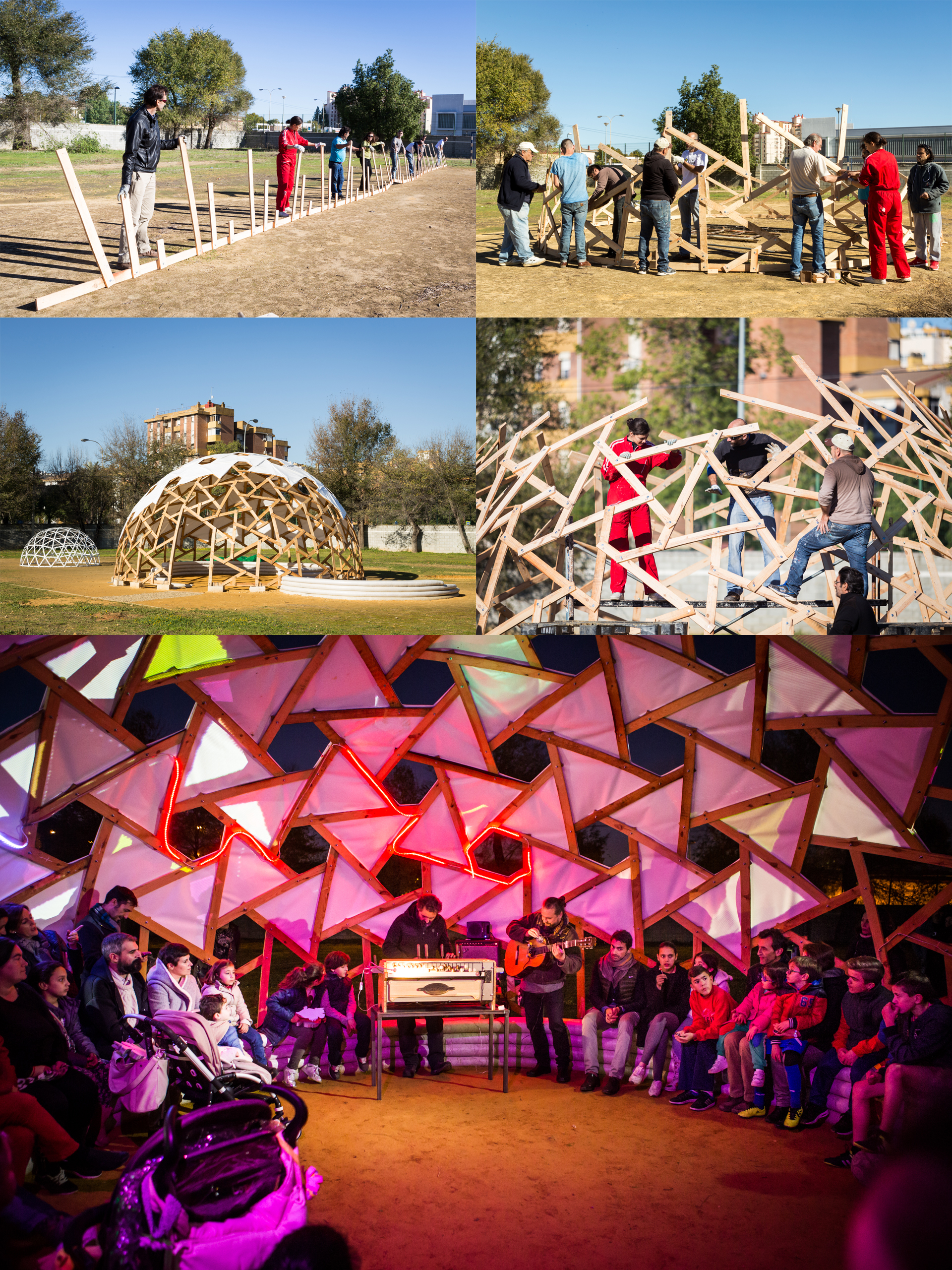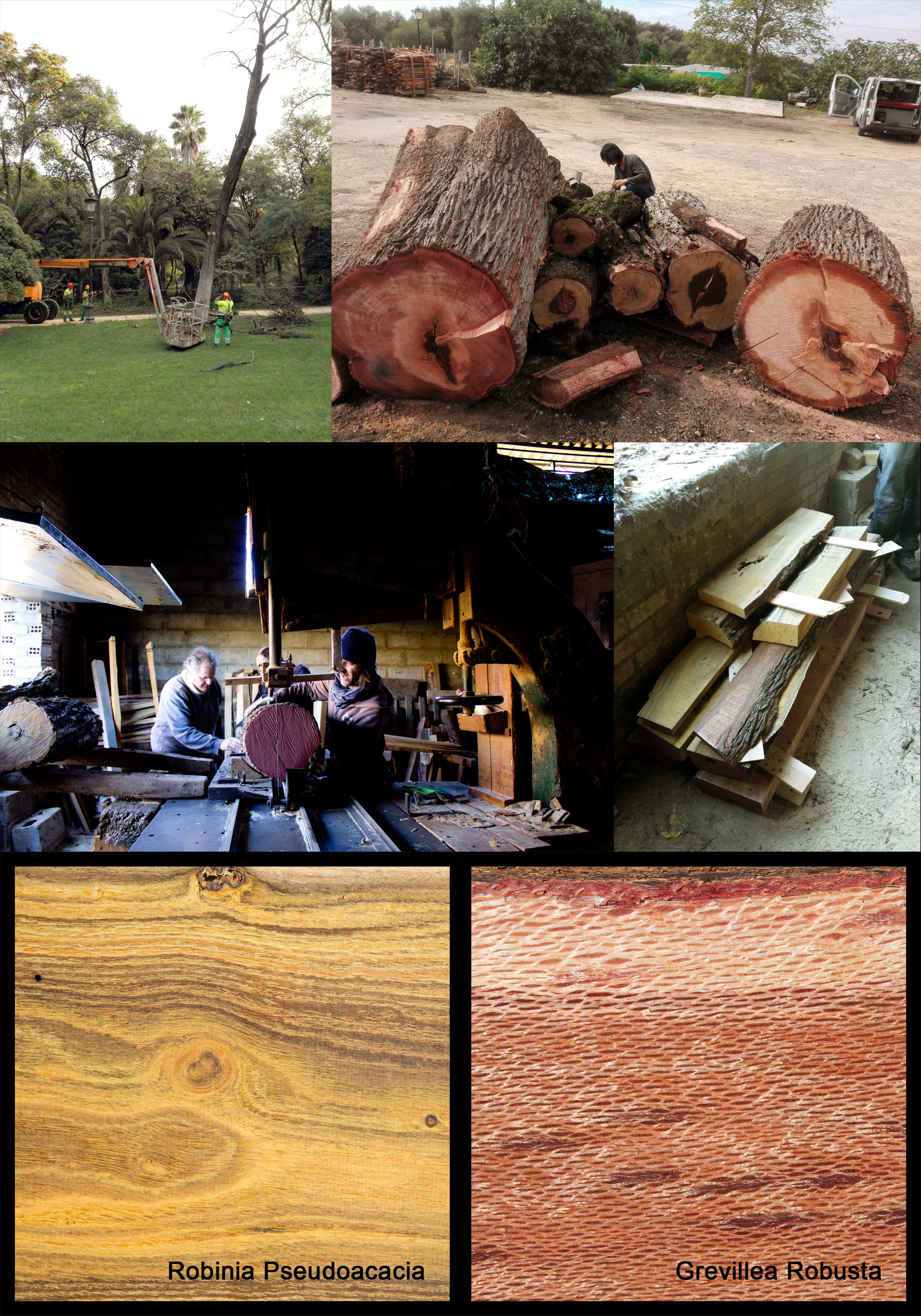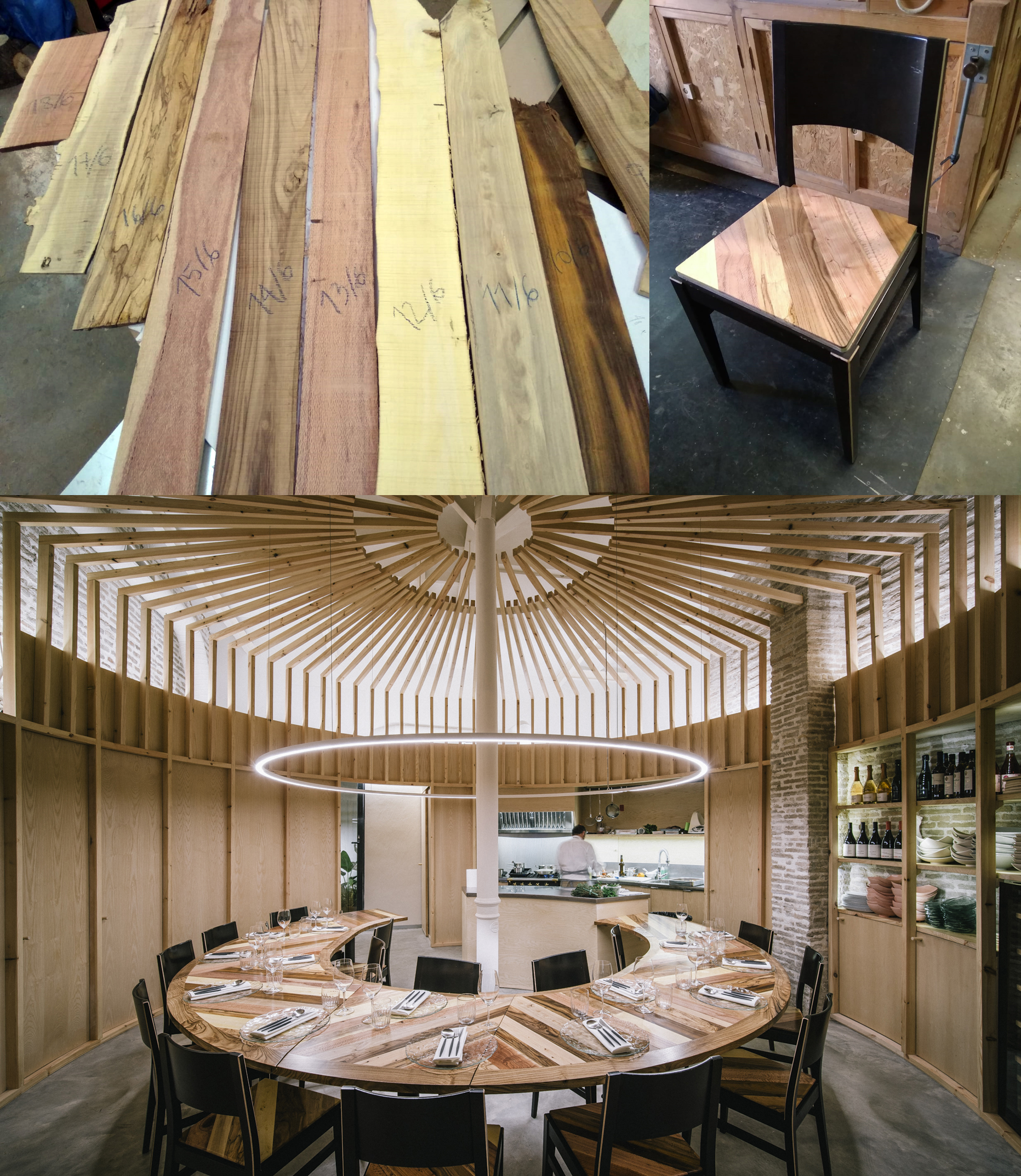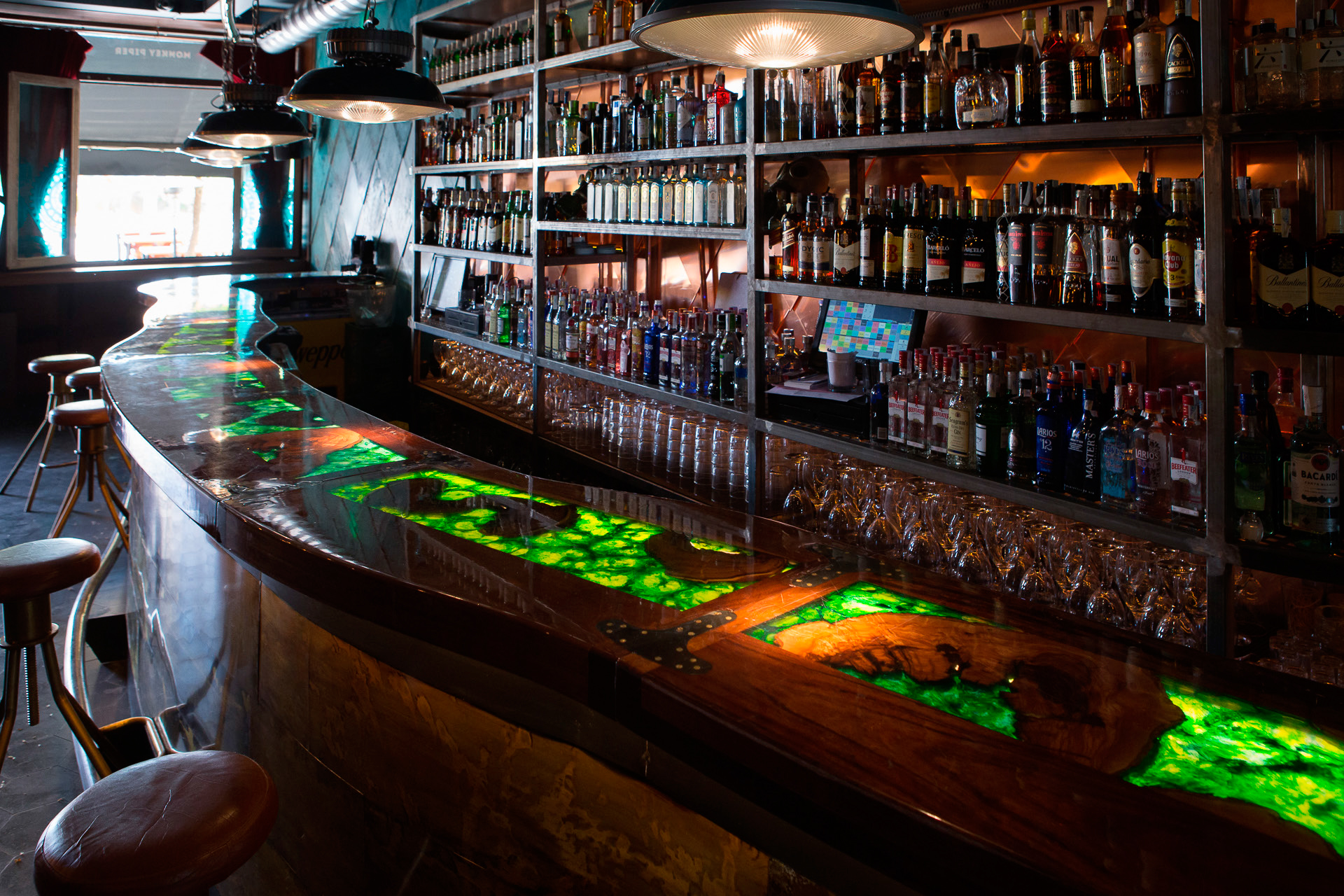Urban trees share the city with its citizens for years. They are aesthetically, psychologically and environmentally beneficial. Society invests money, space and time in them, but at the end of their life cycle, the wood from these trees is managed as worthless and ends up being wasted and even producing more costs without any social return.
The initiative proposes considering wood as a resource that can continue to contribute to society in a cross-cutting and multidisciplinary way
Since 2017 Gianluca Stasi, architect and self-constructor, has been working towards a more modern, sustainable and ecological approach to the management of urban wood that no longer considers the resulting wood as a waste product, but rather proposes to value and manage it as a valuable and noble raw material, zero kilometer, ecological and sustainable, including it in the global vision of the resource cycle.
The wood recovered in different pilot projects has been made available to different local artisans for the manufacture of their works, among which the following stand out:
- 20 Persons Round Table. Ignacio Sanchez, Nicholas Chandler [2019] (Architecture project by Sol89 studio). http://www.fernandoalda.com/en/works/architecture/1165/t-taller-de-cocina
- 12 meters long bar counter. Ignacio Sanchez, Nicholas Chandler [2019]. https://monkeypipersevilla.com
- Stools. Maximilian Kraus [2021]. https://www.instagram.com/p/CSW-kmDInHu/
- Home Table. Ignacio Sanchez [2021]. https://www.instagram.com/ignaciohombredemadera/
Currently the project active and operative, together with Ignacio Sanchez, an association for the valorisation of urban wood is being set up and the aim is to create a quality seal "Madera de Sevilla", which certifies urban wood obtained in a way that respects the environment and society, avoiding wood from massive and controversial cuttings or from other processes that do not respect the natural cycles of trees. The trees used until now have in fact been struck by lightning or fallen during storms, so that their origin was not linked to polemical tree management urban cycles.
Thanks to the association, it will be possible to obtain the cession of a public space to increase the scale of the operations, and thanks to this to structure the initiative for social inclusion, both by activating training programs on employment and the valorisation of the wood obtained and for the production of furniture for public spaces in the city.
Please highlight how the project can be exemplary in this context
Currently, a large amount of human, mechanical and economic resources are devoted to transporting and processing these wood remains to landfill or for biomass or composting, with great public expense and environmental impact, little energy reward and low collective return.
This type of management ends up destroying and wasting a high quality raw material. A wood that has grown slowly and that, like all old wood, has a grain and grain that is unparalleled in comparison to the fast-growing wood found on the market and in commercial circuits today that often has to be bought and bought from great distances.
This initiative promotes a global vision of the life cycle of the urban trees actually mutilated by short-term management. The benefits will be environmental, economic and social.
The initiative allows the reduction of urban waste destined for landfill, the availability of high quality local raw material, at km 0 avoiding transport often imply several hundreds kilometers, to local creators and thus the creation of works more closely linked to the locality and the territory, as well as raising public awareness of the cycles of urban trees.
The projects already carried out confirm the potential in this sense, and in the next phase the aim is to create a xylotheque of the tree species present on the territory in order to strengthen the relationship between citizens and the trees with which they share the streets of the city.
In short, the initiative aims to answer the question of what would happen if the cutting down of these trees were not considered the end of their contribution to the city but the beginning of a new phase, demonstrating that other sustainable and circular schemes are possible and viable.
The project was presented to the city council in 2017 and some trees were salvaged and made available to local craftsmen to prove the viability of the entire proposed cycle as will be detailed later in this document.
Please highlight how the project can be exemplary in this context
A tree, even if it is sick, is not something broken, something that has exhausted its function: even sick trees can hide incredible mosaics of veins and knots caused by fungi and parasites. Characteristic elements that will contribute to the uniqueness of each piece that can be made from them.
The management of public trees is a very interesting area for the application of the concept of circular economy and is undoubtedly a great opportunity to take clear and concrete actions against climate change. In order to implement a sustainable city model in Seville, it is of fundamental importance to minimise waste and its valuation, even better if under schemes that guarantee social, economic and environmental profitability.
We have detected the possibility of reprogramming the cycle of urban trees, to change their paradigm, to stop considering them as a harmful waste, to get rid of as quickly as possible, but as a zero kilometre product of the city; a virtuous resource already available for the promotion of art, crafts and job creation.
Right now, a tree removed from the streets it has inhabited for decades disappears without a trace or memory. We propose new schemes that do not erase trees from the urban landscape but rather enhance their symbolic value, as a memory and witness of the city and the passage of time, proposing artistic, cultural, educational and craft activities that promote the creation of employment, the reduction of waste in urban cycles, awareness and public awareness. In this way, the memory of the tree will remain in the city, contributing to the construction of new narratives with great aesthetic and philosophical values that are strongly linked to the locality.
Please highlight how the project can be exemplary in this context
So far, the initiative has made a high quality resource available to local artisans. The intention is to continue with this scheme so that artists, craftsmen, designers, architects, students and professionals can each interpret it in their own way, to create works and proposals whose hallmark is to value and give continuity to the life of the trees.
At the same time, it is proposed to focus on the socio-ecological value of the initiative, the educational field and the environmental awareness of citizens and consumers, promoting the culture of trees and public space, changing the perception and contributing to the resignification of trees, to serve as a means to raise awareness and generate knowledge among the population about the potential of the changes in environmental policies that are intended to be implemented.
We believe that there is a great opportunity to value the entire life cycle of urban trees and to work towards economic sustainability, efficiency, respect for the environment, the creation of virtuous circles, the improvement of neighborhoods and social inclusion.
The added value created by the valorisation of a resource that is currently managed as a waste can contribute to educational and training activities, social inclusion and participatory and community debate on the future use of the wood resulting from these processes for the adaptation of the same urban spaces and neighborhoods in which these trees have lived all their lives.
Please highlight how this approach can be exemplary
When one participates and observes the entire cycle of wood production, from the tree to the final product, passing through all the intermediate phases, one becomes aware of all the operations necessary to obtain the raw material with which one will work, including the production of waste that can be included in other aspects of the practices carried out. This is a radical change with respect to the acquisition of ready for use pieces of wood, in which all these operations are hidden, increasing and promoting awareness of the tree beyond the wood.
This process can be the subject of didactic activities and professional training, the future use of specific trees can be determined with the participation of the community in which the tree has lived during its life, prolonging a relationship that has been built over the years.
The works made with the wood obtained from these processes have an idiosyncrasy and a relationship with the territory that endow them with environmental and social qualities that differentiate them radically from the standardized products of the global market.
The artisans who have received the wood obtained so far have been able to offer their customers high quality products linked to local narratives, thus increasing the attractiveness and value of the pieces produced and considerably reducing the cost of raw materials, thus increasing competitiveness without reducing quality. At the same time, the wood has been prevented from ending up in a landfill, demonstrating the validity and viability of the proposed schemes.
A wood destined for the landfill has ended up becoming beautiful creations, closing the life cycle of these trees in a way that will remain in value well beyond the life of the tree itself.
These results show the viability of the proposed route, a path to follow in the next phases in which the objective will be to scale up the initiative to the urban scale.
Please also explain the benefits that derived from their involvement.
So far, general citizens have not participated directly in the initiative on a large scale. Projects have been realized with carftmas for specific productions.
In the past the scheme was implemented for participative and community projects such as Sorbole, Gianluca Stasi [2016]: http://www.ctrlz.net/sor-en/
But in that case, as the proposed initiative was not yet underway, the tree was purchased and not salvaged. Actually it could be affirmed that this project and the need to acquire a tree when urban trees were cut around us and the wood underutilized, was one of the reasons to start the initiative itself.
In the next phases the training and teaching activities are increased, as well as the distribution of the wood recovery, so that the participation of society will increase and gain prominence.
The city of Seville alone has 180,000 urban trees. The current management of the resulting wood involves transporting it to a landfill or turning it into sawdust, losing much of its value and implying a large environmental footprint. At the same time, artists and craftsmen experience difficulties and economic barriers in sourcing good quality, slow-growing wood locally.
A cyclical management of urban wood would produce great environmental, social and economic benefits, creating a profit that could be reinvested in the maintenance of urban trees.
If such a program were carried out at the European level, the number of cities and trees involved could be enormous, contributing to a more sustainable, happier, more beautiful and more creative Europe.
Currently, the cycle of urban trees ends the moment the tree is removed from the streets, squares or parks where they inhabited.
The wood is not used according to its potential and is often treated as waste and sent to the landfill. The few initiatives that use it transform it into compost or pellets.
There are few initiatives that intend to reuse part of the urban wood, but none that intend to do so at the urban level and for its real value, involving institutions and society for the benefit of all the subjects involved.
Please provide clear documentation, communication of methodology and principles in this context.
The new Europe has inaugurated a series of initiatives aimed at the configuration of sustainable strategies that promote the quality of the city. There are many European cities that have trees in their streets that contribute to the quality of life in many aspects.
However, the management of urban trees in Seville, as in many other European cities, has not yet joined those sustainable models that advocate "closing the life cycle of products, services, waste, materials, water and energy". This initiative aims to propose that tree management can be added to the virtuous actions already undertaken in other fields of municipal management.
The potential is enormous at the moment in Seville almost 180,000 trees present in the urban fabric of the city are managed.
The proposed management scheme could be easily reproduced by adapting it to local conditions in other European cities, in favor of artists and craftsmen, in collaboration with the communities and avoiding that a precious resource is managed as a waste.
The initiative could be replicated by all those cities that pursue sustainable strategies that promote city quality, economic sustainability, efficiency, respect for the environment, the creation of virtuous circles, the improvement of neighborhoods and social inclusion.
Picture’s captions
1- Sorbole, first project by Gianluca Stasi realized directly obtaining wood from a tree. Participatory project for the construction of a community equipment. Project by Ctrl+z, pictures by Diversofoto.
2- Salvaging process of a trees in Sevilla.
3- Reclaimed urban wood selection, chair and table realized with it. Design by Sol89 Studio, realization Ignacio Sanchez and Nicholas Chandler.
4- Reclaimed urban wood and resin bar counter. Designed and realized by Ignacio Sanchez and Nicholas Chandler.




@GianlucaStasi, 2022
Content licensed to the European Union.